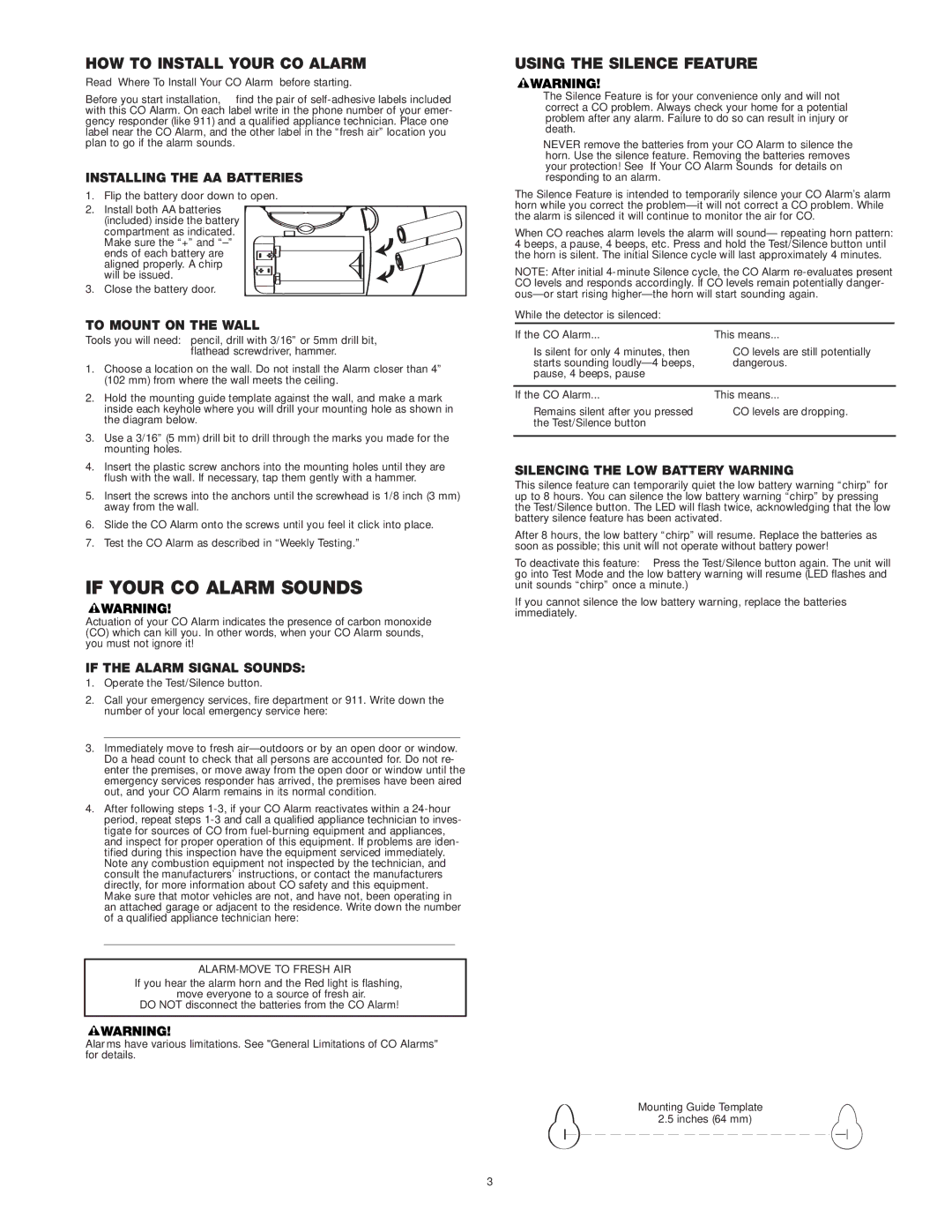HOW TO INSTALL YOUR CO ALARM
Read “Where To Install Your CO Alarm” before starting.
Before you start installation, find the pair of self-adhesive labels included with this CO Alarm. On each label write in the phone number of your emer- gency responder (like 911) and a qualified appliance technician. Place one label near the CO Alarm, and the other label in the “fresh air” location you plan to go if the alarm sounds.
INSTALLING THE AA BATTERIES
1.Flip the battery door down to open.
2.Install both AA batteries (included) inside the battery compartment as indicated. Make sure the “+” and “–” ends of each battery are aligned properly. A chirp
will be issued.
3. Close the battery door.
TO MOUNT ON THE WALL
Tools you will need: pencil, drill with 3/16” or 5mm drill bit, flathead screwdriver, hammer.
1.Choose a location on the wall. Do not install the Alarm closer than 4” (102 mm) from where the wall meets the ceiling.
2.Hold the mounting guide template against the wall, and make a mark inside each keyhole where you will drill your mounting hole as shown in the diagram below.
3.Use a 3/16” (5 mm) drill bit to drill through the marks you made for the mounting holes.
4.Insert the plastic screw anchors into the mounting holes until they are flush with the wall. If necessary, tap them gently with a hammer.
5.Insert the screws into the anchors until the screwhead is 1/8 inch (3 mm) away from the wall.
6.Slide the CO Alarm onto the screws until you feel it click into place.
7.Test the CO Alarm as described in “Weekly Testing.”
IF YOUR CO ALARM SOUNDS
Actuation of your CO Alarm indicates the presence of carbon monoxide (CO) which can kill you. In other words, when your CO Alarm sounds, you must not ignore it!
IF THE ALARM SIGNAL SOUNDS:
1.Operate the Test/Silence button.
2.Call your emergency services, fire department or 911. Write down the number of your local emergency service here:
__________________________________________________________________
3.Immediately move to fresh air—outdoors or by an open door or window. Do a head count to check that all persons are accounted for. Do not re- enter the premises, or move away from the open door or window until the emergency services responder has arrived, the premises have been aired out, and your CO Alarm remains in its normal condition.
4.After following steps 1-3, if your CO Alarm reactivates within a 24-hour period, repeat steps 1-3 and call a qualified appliance technician to inves- tigate for sources of CO from fuel-burning equipment and appliances, and inspect for proper operation of this equipment. If problems are iden- tified during this inspection have the equipment serviced immediately. Note any combustion equipment not inspected by the technician, and consult the manufacturers’ instructions, or contact the manufacturers directly, for more information about CO safety and this equipment.
Make sure that motor vehicles are not, and have not, been operating in an attached garage or adjacent to the residence. Write down the number of a qualified appliance technician here:
_________________________________________________________________
“ALARM-MOVE TO FRESH AIR”
If you hear the alarm horn and the Red light is flashing,
move everyone to a source of fresh air.
DO NOT disconnect the batteries from the CO Alarm!
Alarms have various limitations. See "General Limitations of CO Alarms" for details.
USING THE SILENCE FEATURE
•The Silence Feature is for your convenience only and will not correct a CO problem. Always check your home for a potential problem after any alarm. Failure to do so can result in injury or death.
•NEVER remove the batteries from your CO Alarm to silence the horn. Use the silence feature. Removing the batteries removes your protection! See “If Your CO Alarm Sounds” for details on responding to an alarm.
The Silence Feature is intended to temporarily silence your CO Alarm’s alarm horn while you correct the problem—it will not correct a CO problem. While the alarm is silenced it will continue to monitor the air for CO.
When CO reaches alarm levels the alarm will sound— repeating horn pattern: 4 beeps, a pause, 4 beeps, etc. Press and hold the Test/Silence button until the horn is silent. The initial Silence cycle will last approximately 4 minutes.
NOTE: After initial 4-minute Silence cycle, the CO Alarm re-evaluates present CO levels and responds accordingly. If CO levels remain potentially danger- ous—or start rising higher—the horn will start sounding again.
While the detector is silenced:
If the CO Alarm... | This means... |
Is silent for only 4 minutes, then | CO levels are still potentially |
starts sounding loudly—4 beeps, | dangerous. |
pause, 4 beeps, pause | |
| |
If the CO Alarm... | This means... |
Remains silent after you pressed | CO levels are dropping. |
the Test/Silence button | |
| |
SILENCING THE LOW BATTERY WARNING
This silence feature can temporarily quiet the low battery warning “chirp” for up to 8 hours. You can silence the low battery warning “chirp” by pressing the Test/Silence button. The LED will flash twice, acknowledging that the low battery silence feature has been activated.
After 8 hours, the low battery “chirp” will resume. Replace the batteries as soon as possible; this unit will not operate without battery power!
To deactivate this feature: Press the Test/Silence button again. The unit will go into Test Mode and the low battery warning will resume (LED flashes and unit sounds “chirp” once a minute.)
If you cannot silence the low battery warning, replace the batteries immediately.
Mounting Guide Template
2.5inches (64 mm)
3.875 inches

